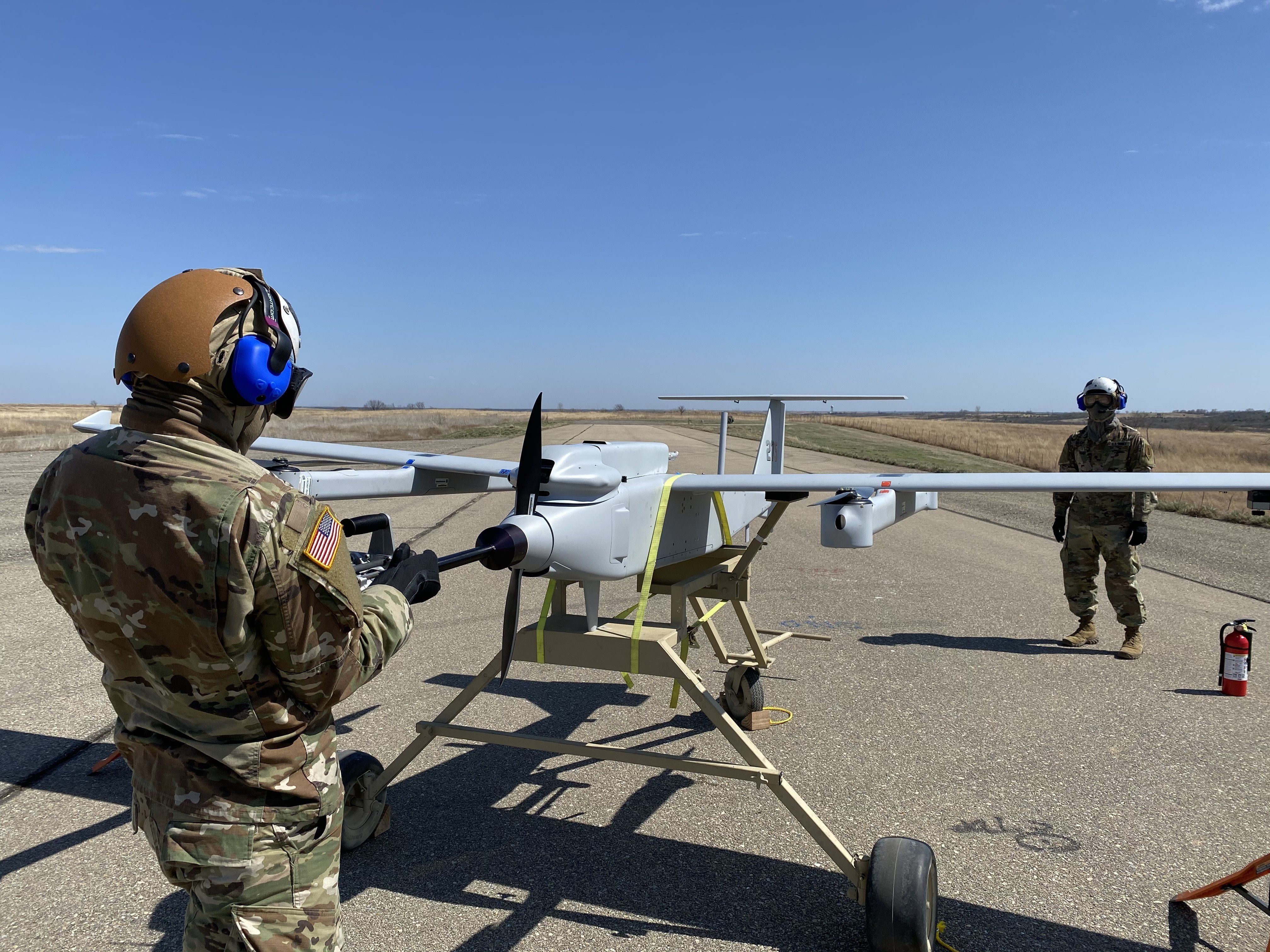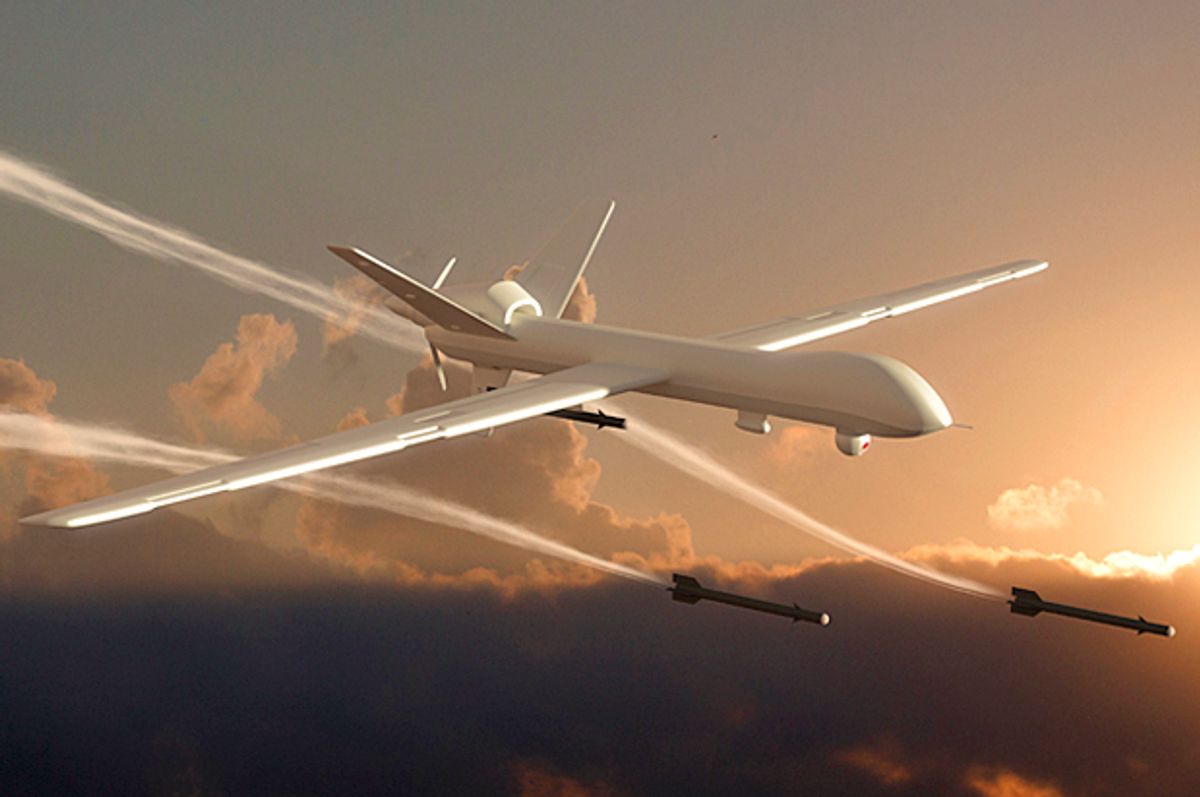Military Fly Drone - A Marine with Task Force Southwest holds up the small Instant Eye unmanned aerial system after flight at Camp Lejeune, NC, February 8, 2017. Allows drone operators to record surveillance and conduct reconnaissance in small confined areas that are otherwise unusable with larger aircraft. Approximately 300 Marines are assigned to Task Force Southwest, whose mission is to train, advise and assist the Afghan National Army's 215th Corps and the 505th Area National Police. (US Marine Corps photo by Sgt. Lucas Hopkins)
The French government recently announced the purchase of 210 mini reconnaissance drones from Thales in 2018. With a wingspan of 12.5 feet, the Spy'Ranger weighs about 32 pounds, making it smaller and more agile than traditional drones.
Military Fly Drone

"It's about the ability to gather the right information at the right time," said Pascal Secretin, head of the Mini Drone product line at Thales. "It's a way to get specific areas of interest before a mission with images processed through the C4I system."
Eda Delivers Final Recommendations For Accommodation Of Large Military Drones In Civil Air Traffic
The French military purchase is indicative of a growing trend toward miniature and even micro drones, a trend underway in the US military. The US Army, Navy and Marine Corps have all sought small, highly flexible platforms.
In February, for example, four Marines from Task Force Southwest demonstrated a new airborne system known as the InstantEye at Marine Corps Base Camp Lejeune in North Carolina. A miniature portable quadcopter drone, the InstantEye can capture images of combat locations, conduct reconnaissance and conduct airstrikes against enemy positions.
But unlike conventional UAVs, the system doesn't require a runway, and can take off and land at 90-degree angles. "We can fly in any direction we want, and we can hover if we need to," said Shawn Sorensen, a small UAS instructor with training and logistics support, which is a significant difference in maneuverability. Is." Activity, in Marine Corps press release.
The small ship can fit into tight spaces and maneuver around curves, giving operators access to a wide range of tactical intelligence.
Over Ukraine, Lumbering Turkish Made Drones Are An Ominous Sign For Russia
The military shares an interest in small-scale drones. At an Executive Office media roundtable event in Fort Belvoir, Va., last spring, Army officials outlined potential uses for a drone that could be as small as a sparrow or even a bumblebee.
The UAS will fly 50 to 70 feet in the air for 10 to 15 minutes, said Col. Phil Cheetham, deputy chief of the Electronics and Special Developments Branch at the Maneuver Center of Excellence at Fort Benning in Georgia.
He said it would be a game-changer for the team's situational awareness. Such craft would likely dominate the scene to the extent of their small arms fire capabilities. Experiments at the Army's combat laboratories have already tested such functionality at the platoon level.

Navy officials have been studying these capabilities since at least 2015, when they announced work on the Close-In Covert Autonomous Disposable Aircraft, or CICADA. These small unmanned systems are designed to move in groups, providing detection capabilities in inaccessible areas.
The Military May Soon Buy The Same Drones You Do
Mini drones are part of the Army's long-term vision. A "Strategic Plan 2046" from the White Sands Missile Range in New Mexico refers to the Perdix drone as part of a "game-changing strategy" going forward. A military demonstration in the fall of 2016 showed 103 of the miniature vehicles launched from three F/A-18 Super Hornets flying in a coordinated swarm.
Why so much action regarding mini drone? Secretin suggests that military leaders may be looking for a way to better master increasingly complex air operations.
"Modern armies have a problem with air control management. To use a large unmanned system, the commander has to plan an air request, sometimes up to 48 hours before the mission. This makes it difficult to respond to the needs of tactical units. is not flexible enough," he said. Told.
A mini drone, or even a swarm of drones, can be launched in minutes without the need for an air traffic control plan.
Explore The Deltaquad Pro Vtol Uav
"An operator can fly one of them after a very short training phase," he said. "It takes one week of training to be able to fly this system, with an additional three to four weeks to learn how to operate the sensors. You've got enough flying time to be able to focus on the main mission." must master the constraints of intelligence gathering."
The Spy'Ranger will fly with an array of sensors and the ability to handle complex intelligence such as tagging visual images with metadata.
"The operator will see the video in real time, he can take a picture very easily, and he'll have the coordinates of literally every pixel in the video along with the metadata, so you have the exact coordinates of every point in an area of interest," he said. .

After a shortfall, the Marines add communications capability to the ACV version. Command and control ACVs originally lacked sufficient long-range secure communications, which have since been added as admittance to the vehicles.
Drone Attack: How Military Drones Are Becoming Deadly Weapons Across The Globe
L3Harris provides experimental navigation satellite delivery, bringing the laboratory closer to completing the first American positioning, navigation and timing experiment in nearly 50 years.
Generative AI Like Viral ChatGPT Lands on DISA Tech Watchlist
The US foreign military sales process requires better communication. Allied countries often do not know what they need or what the United States has to offer to solve their problem.
Warren to FTC: Stop L3Harris-Aerojet deal, cancel Northrop-Orbital ATKsen. Elizabeth Warren is asking federal regulators to oppose one defense merger and cancel another. The Northrop Grumman RQ-4 Global Hawk is a remotely piloted high-altitude surveillance aircraft of the 1990s–2020s. It was originally designed by Ryan Aeronautical (now part of Northrop Grumman) and was known as Tier II+ during development. The RQ-4 provides comprehensive observation and systematic surveillance with long dwell time over target areas using high-resolution Synthetic Aperture Radar (SAR) and Electro-Optical/Infrared (EO/IR) sensors. It can survey up to 40,000 square miles (100,000 km)
Army Confirms Black Hawk, Drone Collided Over New York City
The Global Hawk is operated by the United States Air Force (USAF). It is used as a long duration high altitude platform (HALE).
Expanded intelligence gathering capability to support forces in global military operations. According to the USAF, the aircraft's improved surveillance capability allows for more accurate targeting of weapons and better protection of manpower forces.
Cost overruns reduced the original acquisition plan from 63 aircraft to 45, and a proposal to mothball all 21 Block 30 Smart Signal variants in 2013.

The US Navy developed the Global Hawk into the MQ-4C Triton maritime surveillance platform. Starting in 2022, the US Air Force plans to retire its Global Hawks in 2027.
Military Grade Drone Will Fly Over San Diego Next Year
This section needs to be expanded on: development, background and design history; This article focuses almost entirely on EVTS after 2006-2008. You can help by adding to it. (July 2014)
In the 1990s, the Air Force was developing unmanned aerial intelligence platforms. There was a stealth Lockheed Martin RQ-3 Darkstar; The other was the Global Hawk. Due to budget cuts, only one program could go on. The decision was made to continue with the Global Hawk for its range and payload, instead opting for the stealthy Dark Star.
To evaluate the design and demonstrate its capabilities. RQ-4 capabilities were in high demand in the Middle East; Thus, the prototype aircraft were actively operated by the USAF during the War in Afghanistan. In an unusual move, the aircraft completed initial production at a reduced rate during development and construction. Nine Block 10 production aircraft, sometimes referred to as the RQ-4A, were produced; Two of these were sold to the United States Navy and two others were deployed to support operations in Iraq. The last Block 10 aircraft was delivered on 26 June 2006.
To increase the aircraft's capabilities, the airframe was redesigned, with the nose section and wings extended. Modified aircraft, designated RQ-4B Block 20,
Russia's Long Range Attack Drones
Can carry up to 3,000 lbs (1,360 kg) of internal payload. These changes were introduced with the first Block 20 aircraft, the 17th Global Hawk built, which was introduced at a ceremony on August 25, 2006.
Block 20's first flight took place on March 1, 2007, from USAF Plant 42 at Edwards Air Force Base in Palmdale, California. Development testing of Block 20 took place in 2008.
The United States Navy has taken delivery of two of the Block 10 aircraft to evaluate its maritime surveillance capabilities, designated N-1 (BuNo 166509) and N-2 (BuNo 166510).

The initial naval example was briefly tested at Edwards Air Force Base before being moved to Naval Air Station Patuxt River in March 2006 for the Global Hawk Maritime Demonstration (GHMD) program operated by Navy Squadron VX-20.
General Atomics Mq 1 Predator
In July 2006, GHMD aircraft flew for the first time in the Rim of the Pacific (RIMPAC exercise). Although close to Hawaii, the aircraft were operated from NBVC Point Mugu, which required flights of approximately 2,500 miles (4,000 km) to the region. Four sorties were conducted, resulting in over 24 hours of continuous maritime surveillance coordinated with
Post A Comment:
0 comments so far,add yours